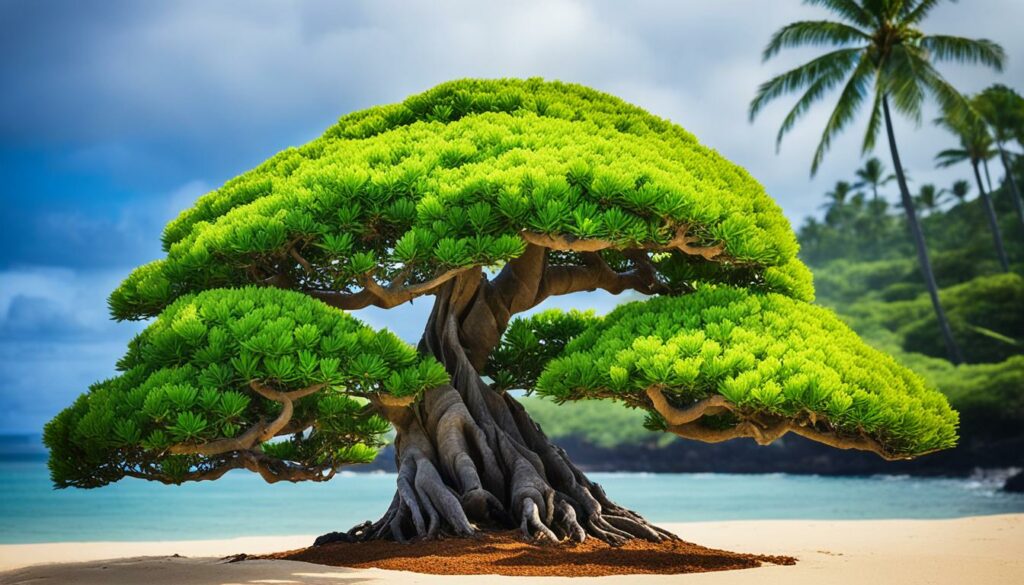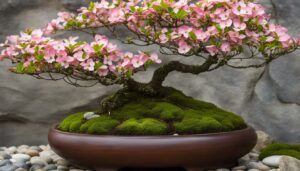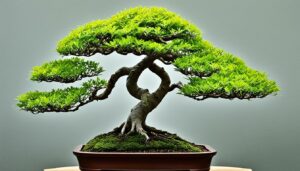If you’re looking for an indoor bonsai tree species that is easy to care for and brings a tropical touch into your home, look no further than the Hawaiian Umbrella. This unique bonsai tree species is known for its attractive foliage and elegant trunk, making it an ideal choice for beginners and enthusiasts alike.
The Hawaiian Umbrella is a species of the Schefflera bonsai tree and is commonly grown indoors. It is prized for its ability to thrive in a variety of settings and climates, making it an ideal choice for those who want to enjoy a beautiful bonsai without the hassle of complicated care requirements.
Key Takeaways
- The Hawaiian Umbrella bonsai tree is a tropical indoor species known for its easy care and unique features.
- This resilient bonsai tree is of the Schefflera species and is popular due to its ability to flourish in various climates.
- With its elegant trunk and attractive foliage, the Hawaiian Umbrella bonsai is perfect for beginners and bonsai enthusiasts.
- Caring for your Hawaiian Umbrella bonsai requires attention to lighting, temperature, humidity, soil type, and repotting needs.
- Preventative measures need to be taken to prevent pests and diseases from affecting your natural indoor bonsai plants.
Exploring the Hawaiian Umbrella Bonsai Tree
The Hawaiian Umbrella bonsai tree, also known as Schefflera bonsai, is a popular indoor bonsai species that is widely admired for its unique appearance and easy-care nature. Schefflera bonsai is a small tree that can reach heights of up to 21 inches and has small green leaves. Its bark is light brown and smooth, making it an ideal indoor bonsai tree.
As an indoor bonsai tree, the Hawaiian Umbrella is an excellent option for those who want to bring a touch of the tropics into their homes. It’s a resilient tree that can withstand low light conditions making it an ideal addition to any home or office.
How To Grow Schefflera Bonsai
Growing a Schefflera bonsai is relatively easy as it thrives in a wide range of growing conditions. When growing indoors, it’s important to place your bonsai tree near a window that receives ample sunlight for at least four hours a day. The ideal temperature range for this tropical bonsai species is between 65-75°F (18-24°C).
In terms of watering, Schefflera bonsai prefers to be kept moist but not wet. The best way to water your bonsai tree is to wait until the top layer of soil is almost dry and then give it a thorough watering.
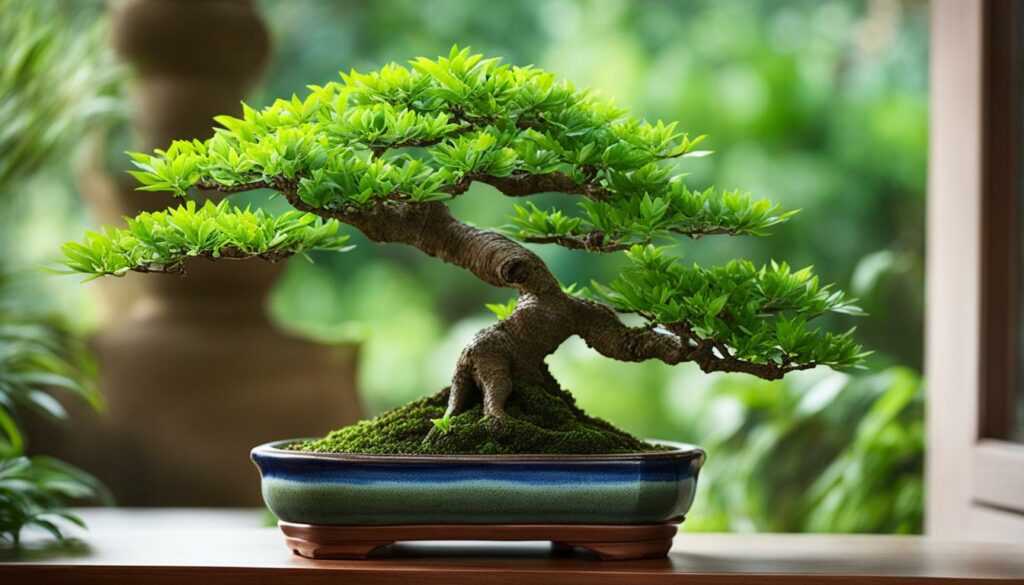
The Ideal Soil for Schefflera Bonsai
The Hawaiian Umbrella or Schefflera bonsai requires regular repotting to maintain its health and appearance. It’s recommended that you repot your bonsai tree every year or two during its growing season. The ideal soil for Schefflera bonsai is a well-draining mix of organic and inorganic material that is slightly acidic with a pH range of 6.0-6.5.
Pruning and Maintenance for Schefflera Bonsai
Regular pruning and maintenance are essential for keeping your Schefflera bonsai healthy and beautiful. Prune your bonsai tree in early spring before it starts producing new growth. You can also prune it throughout the year to maintain its shape and size. Additionally, for maintenance, it’s necessary to keep an eye out for pests and diseases that can damage your bonsai tree. Regularly check your Schefflera bonsai for spider mites and other common pests and diseases.
The Tropical Charm of the Hawaiian Umbrella Bonsai Tree
One of the most appealing aspects of the Hawaiian Umbrella bonsai tree is its tropical charm. With its lush foliage and elegant trunk, this bonsai species has a unique allure that can transform any indoor space into a tranquil paradise. Whether you place it on a windowsill or a tabletop, the Hawaiian Umbrella bonsai tree is sure to captivate your senses.
Another fantastic feature of this indoor bonsai is its easy-care nature. Even if you lack a green thumb, you can still successfully cultivate and maintain this beauty. The Hawaiian Umbrella bonsai tree is perfect for beginners or those seeking a low-maintenance plant to add elegance to their home.
“The Hawaiian Umbrella bonsai has been one of my favorite indoor plants for years. Its tropical appeal never fails to transport me to a peaceful paradise, and I love that it’s so easy to care for!” – Sarah T.
The foliage of the Hawaiian Umbrella bonsai tree is one of its most striking features. Its delicate leaves are arranged in a distinctive pattern, mimicking a versatile umbrella shape that gives it its name. The foliage is also known to change color throughout the year, adding to its visual charm.
The trunk of the Hawaiian Umbrella bonsai tree is equally delightful, featuring a beautifully textured bark that varies in color and depth. This bark provides an exciting visual contrast to the foliage, making it stand out even more.
Overall, the Hawaiian Umbrella bonsai tree is an excellent choice for anyone wanting to bring a touch of the tropics into their home. Its easy-care nature and stunning appearance make it a perfect addition to any indoor space that needs a little extra charm.
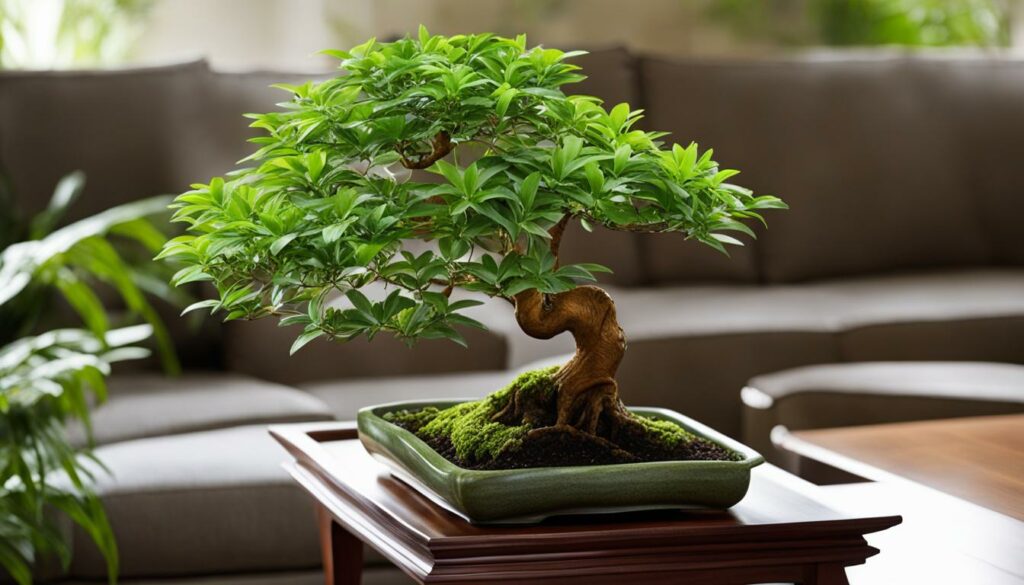
Creating the Ideal Environment for Your Hawaiian Umbrella Bonsai Tree
A thriving Hawaiian Umbrella bonsai tree requires the right environment, lighting, humidity, temperature, and watering. Providing the proper conditions for your indoor bonsai will ensure that it remains healthy and vibrant.
Lighting
Hawaiian Umbrella bonsai trees require bright but indirect light. They thrive in well-lit areas away from direct sunlight, which could burn their foliage. Place your bonsai near a bright window or use grow lights to supplement natural lighting. Turn the tree frequently to ensure even exposure.
Humidity
High humidity is essential for the health of your Hawaiian Umbrella bonsai tree. Mist the tree regularly, or use a humidity tray to maintain moisture levels. Avoid placing the tree near air conditioning or heating vents, which can cause dryness.
Temperature
The ideal temperature range for Hawaiian Umbrella bonsai trees is between 60-75°F (15-24°C). Avoid exposure to extreme temperature fluctuations, as this can damage your bonsai. Use a thermometer to monitor the temperature and adjust as needed.
Watering
Proper watering is crucial for the health of your Hawaiian Umbrella bonsai tree. Water the tree thoroughly when the top one inch (2.5 cm) of soil feels dry. Use room temperature water and avoid overwatering, as this can lead to root rot. A well-draining potting mix is recommended.
Soil Preferences
Hawaiian Umbrella bonsai trees prefer slightly acidic soils, with a pH between 5.5-6.5. Use a well-draining, porous potting mix to avoid waterlogging. Repot the tree every two years to ensure proper root development and soil management.
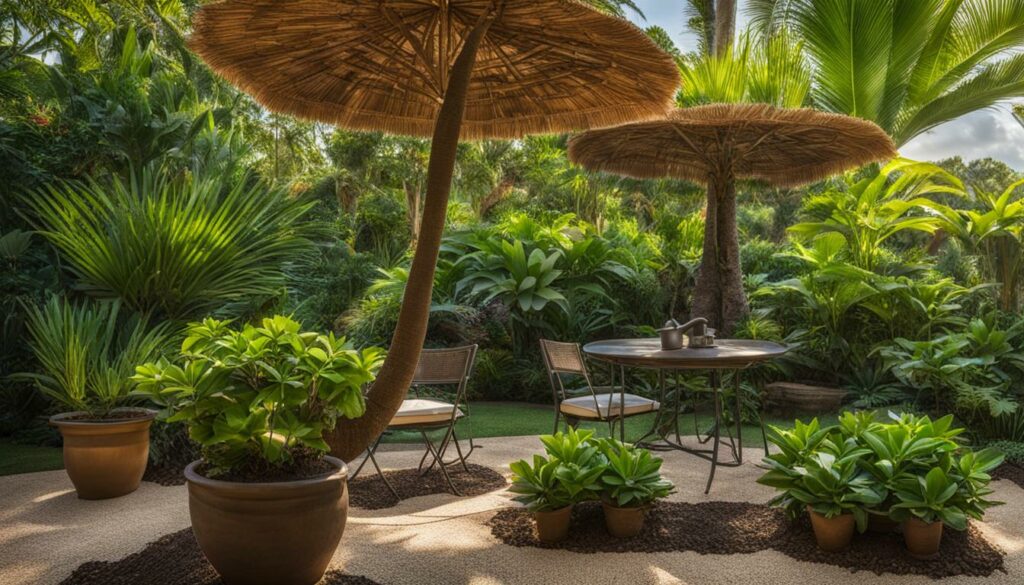
Pruning and Shaping Your Hawaiian Umbrella Bonsai Tree
To help your Hawaiian Umbrella bonsai tree thrive, it’s important to know how and when to prune and shape it. Pruning is the process of removing unwanted branches or leaves, while shaping involves sculpting the tree to create the desired look and proportions. Here’s how you can do it:
Tools Required
To prune and shape your bonsai tree, you’ll need the right tools, including a pair of sharp pruning shears, a root hook, and a pair of bonsai scissors. These tools will help you trim down overgrown branches and shape your tree’s foliage and roots to the desired form.
Pruning Your Tree
Start by inspecting your Hawaiian Umbrella bonsai tree and identifying any branches that are crossing, growing too close together, or brushing up against each other. These should be trimmed to promote healthy growth and prevent disease. Make sure to disinfect your tools before you begin to avoid spreading any bacteria or fungi.
Next, remove any dead or yellowing leaves, which can detract from the tree’s overall appearance and divert energy away from healthy growth. Cut the leaves at their base using your bonsai scissors or shears, being careful not to damage the nearby branches. Remember to trim the tree sparingly and gradually, allowing it to heal between pruning sessions.
Shaping Your Tree
After pruning, you can begin shaping your Hawaiian Umbrella bonsai tree to your liking. Use your fingers to gently bend any pliable branches or stalks to create flowing, natural-looking curves. You can also wire the trunk and branches to hold them in place as they develop a new shape. However, be careful not to wire too tightly as it can damage the tree’s bark.
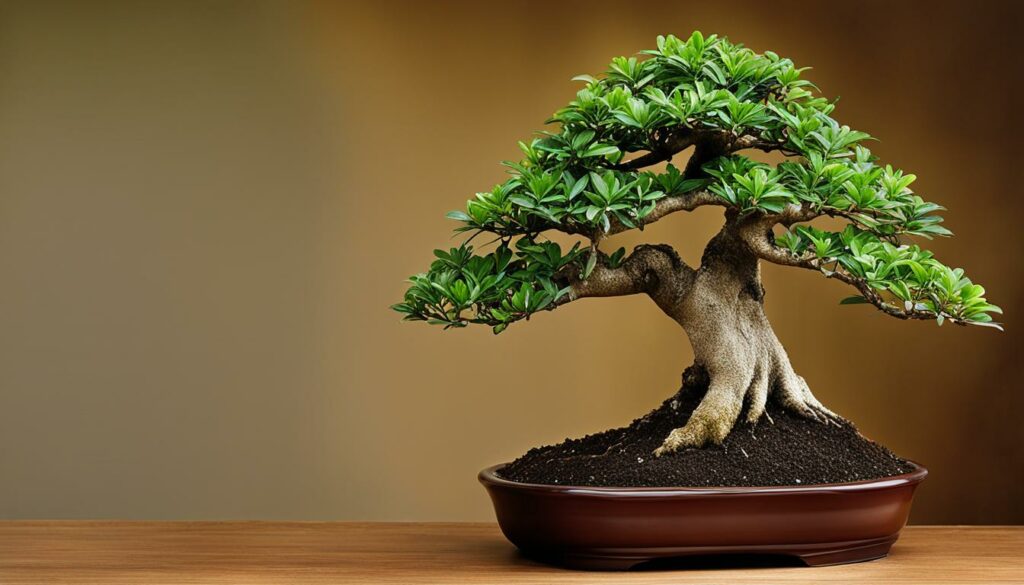
Repotting and Soil Considerations for the Hawaiian Umbrella Bonsai Tree
As your Hawaiian Umbrella bonsai tree grows, it will eventually need to be repotted to freshen up the soil and provide more space for its roots to expand. Repotting also gives you an opportunity to inspect the roots for any signs of disease or pests. Here’s what you need to know about repotting and soil considerations for your indoor bonsai tree:
When to Repot
The general rule of thumb is to repot your Hawaiian Umbrella bonsai tree every two years. However, you can also check the root system to see if it has outgrown its current container. Signs that it’s time to repot include roots growing out of the drainage holes or circling around the root ball, as well as a decrease in growth or yellowing leaves.
How to Repot
To repot your bonsai, gently remove it from its container and gently loosen the root ball. Trim away any dead or damaged roots, but avoid cutting off more than one-third of the root system. Place the tree in a new container with fresh soil mix, ensuring that the soil is well-draining and not too heavy. Water thoroughly and keep your bonsai in a shaded area for a few days to minimize shock.
Suitable Soil Mixtures
The ideal soil mixture for your Hawaiian Umbrella bonsai tree should be well-draining and able to hold moisture. A suitable mixture is equal parts peat moss, perlite or sand, and akadama or bonsai soil mix. Avoid using regular garden soil or potting soil, which can become compacted and prevent proper drainage.
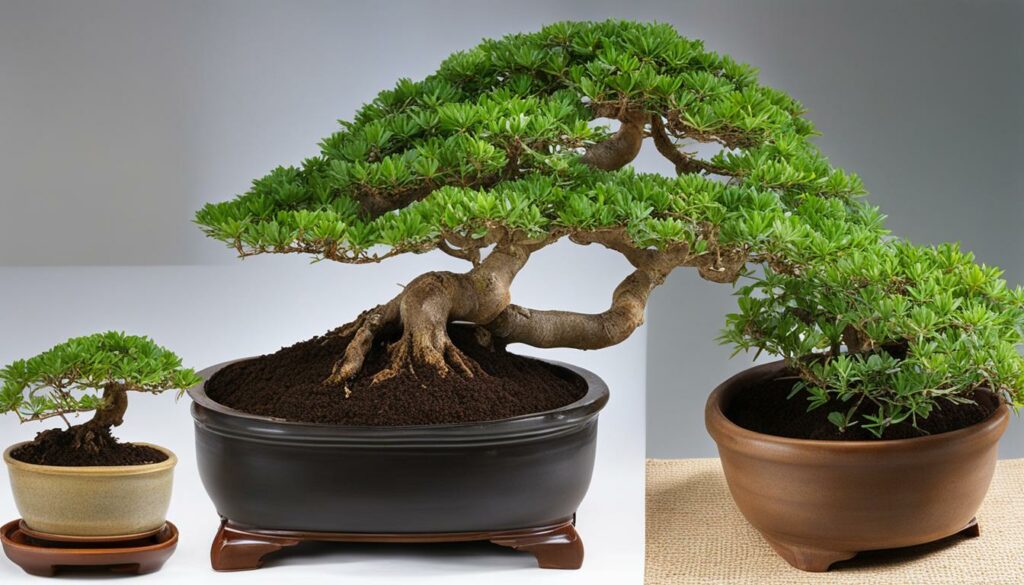
Preventing Root Rot
One common issue with indoor bonsai trees is root rot, caused by overwatering or poor drainage. To prevent this, make sure your container has drainage holes and that the soil mixture is well-draining. Water your bonsai thoroughly, but allow the soil to dry out slightly before watering again. Also, avoid using a saucer to catch excess water, as it can keep the soil too moist for too long.
By following these simple repotting and soil considerations for your Hawaiian Umbrella bonsai tree, you can ensure its overall health and vitality for years to come.
Preventing Pests and Diseases in Your Hawaiian Umbrella Bonsai Tree
Caring for your Hawaiian Umbrella bonsai tree doesn’t end with maintaining optimal growing conditions. Despite their resilience, these plants can still become vulnerable to pests and diseases that attack their foliage, roots, and trunk. By being vigilant and taking preventive measures, you can keep your bonsai thriving and free from harm.
Common Pests That Affect Indoor Bonsai Trees
The following are some of the most common pests that bonsai enthusiasts should watch out for in their Hawaiian Umbrella trees:
| Pest Type | Description | Prevention and Treatment |
|---|---|---|
| Aphids | Tiny, pear-shaped insects that feed on sap and cause curled leaves and stunted growth. | Avoid over-fertilizing and keep the tree in a well-ventilated area. Use insecticidal soap or neem oil to deter and eliminate aphids. |
| Spider mites | Microscopic pests that cause webbing and discoloration on leaves and branches. | Keep the tree humid and avoid letting the soil dry out. Spray the tree with water or use miticide to control spider mite infestations. |
| Scale insects | Small, immobile insects that appear as bumps on leaves and branches, sucking sap and causing yellowing and leaf drop. | Use rubbing alcohol or horticultural oil to remove and kill scale insects. Avoid over-watering and fertilizing, as this can attract these pests. |
| Mealybugs | Soft-bodied, white insects that secrete a sticky substance and cause yellowing and wilting of foliage. | Isolate the tree from other plants and remove mealybugs manually with a cotton swab or spray with insecticidal soap or neem oil. Avoid over-watering and ensure proper drainage. |
Common Diseases That Affect Indoor Bonsai Trees
In addition to pests, Hawaiian Umbrella bonsai trees can also fall victim to fungal or bacterial diseases that weaken their immune system and cause leaf spots, cankers, and dieback.
Bonsai Tip: Overwatering and poor drainage can lead to root rot and other soil-borne diseases. Be sure to use a well-draining soil mix and avoid watering the tree excessively.
Prevention and Treatment for Bonsai Tree Diseases
The following tips can help prevent and treat common diseases that affect bonsai trees:
- Practice good hygiene by regularly removing dead leaves, branches, and debris from around the tree.
- Avoid overcrowding and excessive humidity, which can promote fungal growth.
- Use fungicides or bactericides when needed, following the instructions carefully.
- Isolate affected trees to prevent the spread of disease.
Bonsai trees require careful attention and maintenance to remain healthy and vibrant. By keeping an eye out for common pests and diseases, and taking prompt action when needed, you can enjoy the beauty and tranquility of your Hawaiian Umbrella bonsai tree for years to come.
Showcasing the Hawaiian Umbrella Bonsai in Your Home
Now that you have your beautiful Hawaiian Umbrella bonsai thriving in your indoor space, it’s time to showcase it in style. Here are a few ideas to help you create an attractive and serene display:
- Choose a container that complements the colors and style of your living space. A simple ceramic pot in a neutral hue will make your bonsai the centerpiece.
- Position your bonsai near a window with filtered sunlight. The silhouette of this tropical beauty against a soft sunbeam will elevate the ambiance of your living room.
- Consider accessorizing the display with natural decor such as rocks, pebbles, or sand, for a relaxing and zen-like feel.
- If you have other indoor plants, place the Hawaiian Umbrella bonsai next to them, creating a green oasis that will boost your mood and purify the air.
By following these simple ideas, you can showcase your Hawaiian Umbrella bonsai as an effortless and elegant piece of home decor. A touch of green in any living space is always welcome, and this easy-care indoor bonsai will bring both calming energy and a tropical vibe to your home.
Conclusion
Congratulations! You now have a comprehensive understanding of the Hawaiian Umbrella bonsai tree and how to care for it in your home. This easy-care, indoor bonsai species is a great way to bring a touch of the tropics into your living space.
Remember to provide your bonsai with the optimal environment, including suitable lighting, temperature, humidity, watering, and soil conditions. Additionally, regular pruning, shaping, and repotting will ensure its longevity and continued health. Prevention and treatment of pests and diseases are also crucial for maintaining a thriving bonsai.
By following the guidelines provided in this article, you can showcase the beauty and charm of the Hawaiian Umbrella bonsai tree in your home. Its unique foliage, trunk, and overall appearance make it an elegant and tranquil addition to any interior. We hope you enjoy caring for and admiring your new bonsai!
FAQ
What is the Hawaiian Umbrella bonsai tree?
The Hawaiian Umbrella bonsai tree, scientifically known as Schefflera, is a tropical indoor bonsai species. It is popular for its unique foliage and easy-care nature.
How do I care for a Hawaiian Umbrella bonsai tree?
Caring for a Hawaiian Umbrella bonsai tree is relatively simple. It thrives in bright, indirect light and prefers well-draining soil. Water the bonsai when the top inch of soil feels dry, and avoid overwatering. Maintaining a moderate humidity level and periodically fertilizing the tree will also promote healthy growth.
Can I grow a Hawaiian Umbrella bonsai tree indoors?
Yes, the Hawaiian Umbrella bonsai tree is well-suited for indoor cultivation. Its compact size and adaptability to the average room conditions make it an ideal choice for enthusiasts who want to enjoy the beauty of bonsai trees indoors.
Is the Hawaiian Umbrella bonsai tree easy to care for?
Yes, the Hawaiian Umbrella bonsai tree is relatively easy to care for. It is a resilient species that can tolerate a range of conditions. With proper watering, lighting, and occasional pruning, anyone can successfully care for and maintain a healthy Hawaiian Umbrella bonsai tree.
How often should I prune my Hawaiian Umbrella bonsai tree?
Pruning frequency for the Hawaiian Umbrella bonsai tree depends on the desired shape and size. However, light pruning to maintain its form can be done throughout the year. Major pruning should be done in early spring or late fall to promote new growth and maintain the desired proportions of the bonsai.
How often should I repot my Hawaiian Umbrella bonsai tree?
Hawaiian Umbrella bonsai trees should be repotted every 2-3 years, typically during early spring before new growth emerges. However, if the roots are overcrowded or the soil quality is poor, repotting may be necessary sooner.
How do I prevent pests and diseases in my Hawaiian Umbrella bonsai tree?
To prevent pests and diseases in your Hawaiian Umbrella bonsai tree, monitor its health closely and take prompt action if any signs of problems arise. Regularly inspect the foliage and branches for pests, and maintain good hygiene by removing fallen leaves. Providing proper ventilation and optimal growing conditions will also help keep pests and diseases at bay.
Can I display my Hawaiian Umbrella bonsai tree indoors?
Yes, the Hawaiian Umbrella bonsai tree is an excellent choice for indoor display. Its compact size and elegant appearance make it a captivating addition to any room. Just ensure it receives adequate light and is positioned in a place where it can be appreciated and admired.
Is the Hawaiian Umbrella bonsai tree suitable for beginners?
Yes, the Hawaiian Umbrella bonsai tree is a great option for beginners due to its forgiving nature and easy-care requirements. With proper guidance and regular care, even novice bonsai enthusiasts can successfully grow and maintain a Hawaiian Umbrella bonsai tree.
